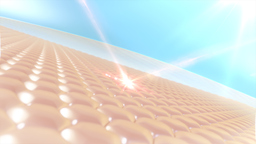A New Tool / Agent for Therapy and Skin Protection
TECHNOLOGY NUMBER: 7280

OVERVIEW
A novel type of photoreceptor which readily absorbs UVA and UVB rays- LITE-1 is an ideal organic additive to sunscreens to absorb UV rays
- Can serve as a therapeutic tool to determine light sensitivity of cells and tissues
BACKGROUND
Ultraviolet radiation comes naturally from the sun or alternatively from man-made sources such as tanning beds or welding torches. The ultraviolet radiation produced by the sun can be separated into ultraviolet A (UVA) and ultraviolet B (UVB) groupings. While both UVA and UVB radiation can cause a number of damaging effects to the skin and have been associated with carcinomas and malignant melanomas, UVB rays are more associated with the deleterious effects of sun exposure over a lifetime.
Over the past several decades, increased knowledge about the effects of UV exposure have led to guidance on behaviors to minimize the effects of sun exposure. In addition to recommendations to stay in the shade, to avoid the sun in the heat of the day, and to wear protective clothing to minimize areas of skin exposure, the regular use of sunscreen has been advocated by healthcare professionals. While the use of sunscreen is helpful in decreasing the effects of sunlight on skin, it has unfortunately only shown a 25% decrease of skin related tumors and diseases from the protection of harmful UVA and UVB rays. A need exists to discover additional agents that provide skin protection from the sun.
INNOVATION
Researchers have discovered that the nematode protein LITE-1 is a novel type of photoreceptor which readily absorbs wavelengths in the UVA and UVB spectrum and can resist photo bleaching from UVB wavelengths. LITE-1 can be distinguished from known photoreceptors by an exceptionally high efficiency in photo absorption, making it an ideal organic additive to sunscreens for skin protection against harmful UV rays present in sunlight. Recombinant LITE-1 can easily be purified through affinity chromatography, providing sufficient concentrations with which to work. The addition of substances such as tryptophan residues augment LITE-1 function and can be introduced into other proteins to confer photosensitivity, thereby suggesting a potential route for genetically engineering novel photoreceptors through this approach. Namely, upon expression of LITE-1 or its derivatives, other cells or tissues can become sensitive to light. Thus, LITE-1 and its derivatives may be used as a novel therapeutic tool, which can be turned on or off with light, to intervene in the function of cells, tissues and organs of patients and healthy individuals. The photosensitive properties of LITE-1 also create an opportunity for its use beyond medicine in the fields of materials science and engineering.